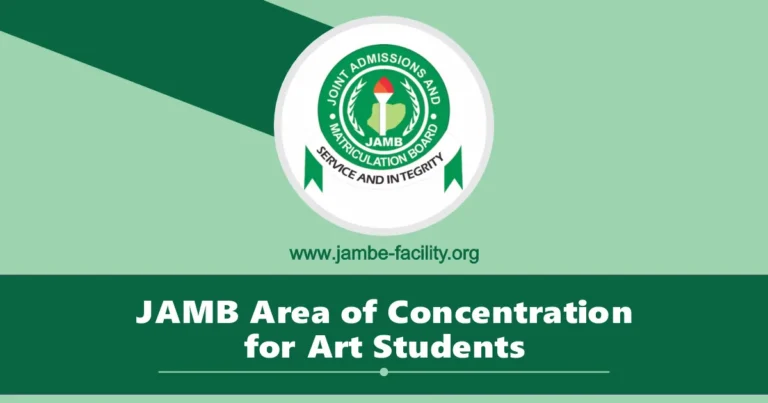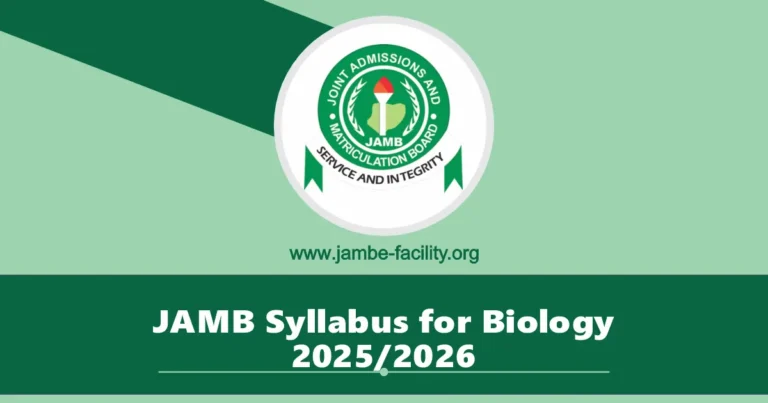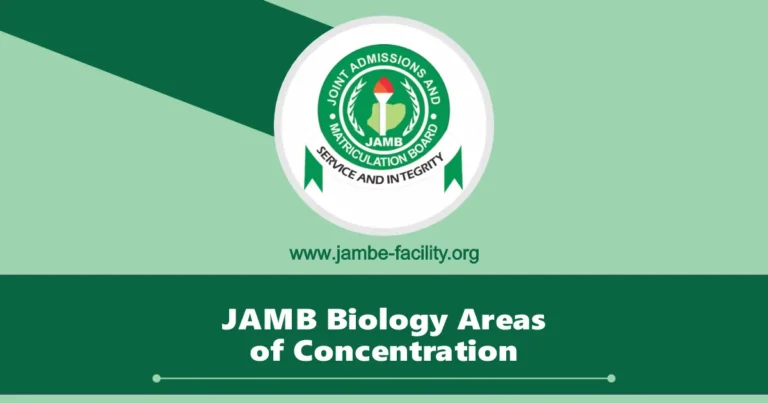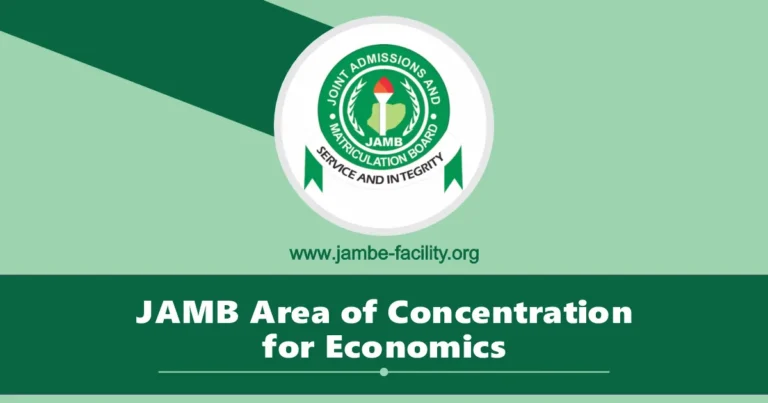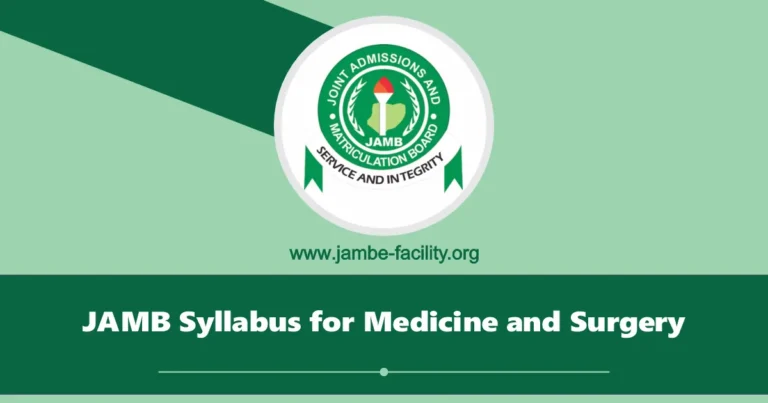JAMB Syllabus for Biology 2025/2026 PDF Download

Are you interested in the JAMB syllabus for Biology 2025/2026? See below as this article is primarily centered on the different topics for the different sections of questions.
This article will narrow down your reading as we have highlighted the different topics and areas you should center your read.
JAMB Syllabus for Biology 2025/2026
Section A: Variety of Organisms
1. Living organisms:
Topics:
- Characteristics
- Cell structure and functions of cell Components
- Level of organization
i. Cell e.g. Euglena and Paramecium
ii. Tissue, e.g. epithelial tissues and Hydra
iii. Organ, e.g. onion bulb
iv. Systems, e.g. reproductive, digestive, and excretory
v. Organisms e.g. Chlamydomonas
2. Evolution among the following:
Topics:
- Monera (prokaryotes), e.g. bacteria and blue-green algae.
- Protista (protozoans and protophyta), e.g. Amoeba, Euglena, and Paramecium
- Fungi, e.g. mushroom and Rhizopus.
- Plantae (plants)
i. Thallophyta (e.g. Spirogyra)
ii. Bryophyta (mosses and liverworts) e.g. Brachymenium and Marchantia
iii. Pteridophyta (ferns) e.g. *Dryopteris*
iv. Spermatophyta (Gymnospermae and Angiospermae)
- Gymnosperms e.g. cycads and conifers.
- Angiosperms (monocots, e.g. maize; dicots, e.g. waterleaf)
e. Animalia (animals)
i. Invertebrates
- Coelenterate (e.g. Hydra)
- Platyhelminthes (flatworms) e.g. Taenia
- Nematoda (roundworms)
- Annelida (e.g. earthworm)
- Arthropoda e.g. mosquito, cockroach, housefly, bee, butterfly
- Mollusca (e.g. snails)
ii. Multicellular animals (vertebrates)
- Pisces (cartilaginous and bony fish)
- Amphibia (e.g. toads and frogs)
- Reptilia (e.g. lizards, snakes, and turtles)
- Aves (birds)
- Mammalia (mammals)
3. Variety of Organisms
Topics:
- Structural/functional and behavioral adaptations of organisms.
- Adaptive colouration and its functions
- Behavioral adaptations in social animals
- Structural adaptations in organisms.
Section B: Form and Functions
1. Internal structure of a flowering plant
Topics:
i. Root
ii. Stem
iii. Leaf
b. Internal structure of a mammal
2. Nutrition
Topics:
a. Modes of nutrition
i. Autotrophic
ii. Heterotrophic
b. Types of Nutrition
c. Plant nutrition
i. Photosynthesis
ii. Mineral requirements (macro and micro-nutrients)
d. Animal nutrition
i. Classes of food substances: carbohydrates, proteins, fats and oils, vitamins, mineral salts, and water
ii. Food tests (e.g. starch, reducing sugar, protein, oil, fat, etc.)
iii. The mammalian tooth (structures, types, and functions)
iv. Mammalian alimentary canal
v. Nutrition process (ingestion, digestion, absorption, and assimilation of digested food)
3. Transport
Topics:
a. Need for transportation
b. Materials for transportation. (Excretory products, gasses, manufactured food, digested food, nutrient, water, and hormones)
c. Channels for transportation
i. Mammalian circulatory system (heart, arteries, veins, and capillaries)
ii. Plant vascular system (phloem and xylem)
d. Media and processes of mechanism for transportation.
4. Respiration
Topics:
a. Respiration
b. Respiratory organs and surfaces
c. The mechanism of gaseous exchange in:
i. Plants
ii. Mammals
d. Aerobic respiration
e. Anaerobic respiration
5. Excretion
Topics:
a. Types of excretory structures:
i. contractile vacuole
ii. flame cell
iii. nephridium
iv. Malpighian tubule
v. kidney
vi. stoma and lenticel
b. Excretory mechanisms:
i. Kidneys
ii. Lungs
iii. Skin
c. Excretory products of plants
6. Support and movement
Topics:
a. Tropic, tactic, nastic, and sleep movements in plants
b. Supporting tissues in animals
c. Types and functions of the skeleton
i. Exoskeleton
ii. Endoskeleton
iii. Functions of the skeleton in animals
7. Reproduction
Topics:
a. Asexual reproduction
i. Fission as in Paramecium
ii. Budding as in yeast
iii. Natural vegetative propagation
iv. Artificial vegetative propagation
b. Sexual reproduction in flowering plants
i. Floral parts and their functions
ii. Pollination and fertilization
iii. Products of sexual reproduction
c. Reproduction in mammals
i. Structures and functions of the male and female reproductive organs
ii. Fertilization and development (Fusion of gametes)
8. Growth
Topics:
a. Meaning of growth
b. Germination of seeds and conditions necessary for germination of seeds
9. Coordination and control
Topics:
a. Nervous coordination:
i. The components, structure, and functions of the central nervous system
ii. The components and functions of the peripheral nervous systems
iii. Mechanism of transmission of impulses
iv. Reflex action
b. The sense organs
i. Skin (tactile)
ii. Nose (olfactory)
iii. Tongue (taste)
iv. Eye (sight)
v. Ear (auditory)
c. Hormonal control
i. Animal hormonal system
- Pituitary
- Thyroid
- Parathyroid
- Adrenal gland
- Pancreas
- Gonads
ii. Plant hormones (phytohormones)
d. Homeostasis
i. Body temperature regulation
ii. Salt and water regulation
Section C. Ecology
1. Factors affecting the distribution of Organisms
Topics:
i. Abiotic
ii. Biotic
2. Symbiotic interactions of plants and animals
Topics:
(a) Energy flow in the ecosystem: food chains, food webs and trophic levels
(b) Nutrient cycling in nature
i. carbon cycle
ii. water cycle
iii. Nitrogen cycle
3. Natural Habitats
Topics:
(a) Aquatic (e.g. ponds, streams, lakes seashores and mangrove swamps)
(b) Terrestrial/arboreal (e.g. tree-tops of oil palm, abandoned farmland or a dry grassy (savanna) field, and burrow or hole.
4. Local (Nigerian) Biomes
Topics:
a. Tropical rainforest
b. Guinea savanna (southern and northern)
c. Sudan Savanna
d. Desert
e. Highlands of montane forests and grasslands of the Obudu, Jos, Mambilla Plateau.
5. The Ecology of Populations:
Topics:
(a) Population density and overcrowding.
(b) Adaptation for survival
i. Factors that bring about competition
ii. Intra and inter-specific competition
iii. Relationship between competition and succession.
(c) Factors affecting population sizes:
i. Biotic (e.g. food, pest, disease, predation, competition, reproductive ability).
ii. Abiotic (e.g. temperature, space, light, rainfall, topography, pressure, pH, etc.
(d) Ecological succession
i. primary succession
ii. secondary succession
6. Soil
Topics:
a) characteristics of different types of soil (sandy, loamy, clayey)
i. soil structure
ii. porosity, capillarity and humus content
b). Components of the soil
i. inorganic
ii. organic
iii. soil organisms
iv. Soil air
v. Soil water
c) Soil fertility:
i. loss of soil fertility
ii. Renewal and maintenance of soil fertility
7. Humans and Environment
Topics:
(a) Diseases:
(i) Common and endemic diseases.
ii. Easily transmissible diseases and disease syndrome such as:
- poliomyelitis
- cholera
- tuberculosis
- sexually transmitted disease/syndrome (gonorrhea, syphilis, AIDS, etc.
b. Pollution and its control
(i) sources, types, effects and methods of control.
(ii) Sanitation and sewage
(c) Conservation of Natural Resources
(d) Game reserves and National parks
SECTION D: Heredity and Variations
(I) Variation In Population
Topics:
a. Morphological variations in the physical appearance of individuals.
(i) size (height, weight)
(ii) Colour (skin, eye, hair, coat of animals, scales and feathers)
(iii) Fingerprints
b. Physiological variation
(i) Ability to roll tongue
(ii) Ability to taste phenylthiocarbamide (PTC)
(iii) Blood groups
c. Application of discontinuous variation in crime detection, blood transfusion and determination of paternity.
2. Heredity
Topics:
a) Inheritance of characters in organisms;
i) Heritable and non-heritable characters.
b) Chromosomes – the basis of heredity;
(i) Structure
(ii) Process of transmission of hereditary characters from parents to offspring.
c) Probability in genetics and sex determination.
d) Application of the principles of heredity in:
i) Agriculture
ii) Medicine
e. Sex-linked characters e.g. baldness, haemophilia, color blindness, etc.
SECTION E: Evolution
1. Theories of evolution
Topics:
a) Lamarck’s theory
b) Darwin’s theory
c) organic theory
Conclusion
Depending on your course of study, passing Biology may be a key criteria to gaining admission. We’ve disclosed how you can score high in JAMB.
Overall, following JAMB Syllabus for Biology ensure you ace the 2025/2026 UTME with flying colours. If you have any question let us know in the comment section below.


